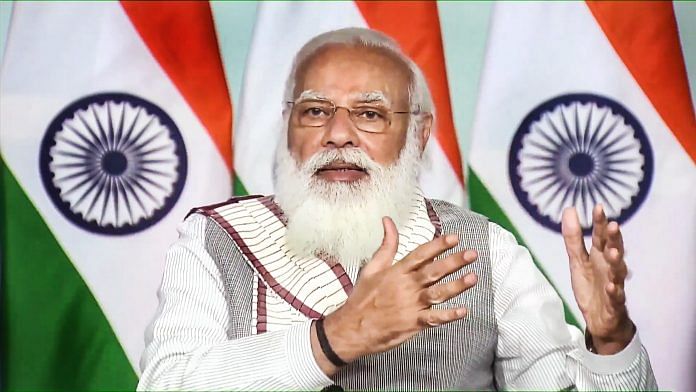
Thank you dear subscribers, we are overwhelmed with your response.
Your Turn is a unique section from ThePrint featuring points of view from its subscribers. If you are a subscriber, have a point of view, please send it to us. If not, do subscribe here: https://theprint.in/
Three remarkable events impacting India took place in August. First, the impressive trajectory of our vaccination drive against the Covid-19 pandemic after much hiccups. Second, the Taliban’s reconquest of Afghanistan. And third, the Narendra Modi government’s National Monetization Plan that aims to raise over Rs 6 lakh crore through asset leases to fund an even ambitious infrastructure pipeline.
Therefore, this August can be used to gauge the Modi government’s performance in three critical realms — crisis management, foreign policy and economy.
Firstly, crisis management. After a chaotic start to a national vaccination drive, the last month saw the Union get its act together and bring discipline to the inoculation efforts. Cash flows to domestic vaccine manufacturers helped them to scale up production. The government approved three more vaccines. State CMs are no longer complaining of vaccine shortages. Schools are reopening and painstaking lockdowns in urban centers are lifted.
Following the devastating Covid-19 second wave in April and May, Narendra Modi’s image took a massive hit. Staying out of public light in those months seemed a deliberate strategy to somehow skid public anger away from a ‘visible’ Prime Minister. Now that the indignation has tapered, the government has plastered Modi’s photo all over thanking him for (taxpayer-funded) ‘World’s largest Free Vaccination Drive’.
Now the focus is to manage public expectations not by foolish triumphalism but through actions like robust inoculation and lockdown phaseouts.
Second, Afghanistan. Modi, known for his realpolitik approach in politics, failed to employ that art in foreign policy in India’s neighbourhood. Even while America under Trump started courting the Taliban in 2018 for peace and preparing a NATO exit, India remained etched into the ‘Afghan-led, Afgan-owned’ bubble. The Taliban was being actively flirted with by the Russians, Iranians, Chinese, and Turks as they foresaw an inevitable strategic realignment in Kabul.
Washington desperately prepared for an out, Rawalpindi laid ground for a Taliban return and Beijing kept its carrot ready. All this while, New Delhi placed all bets on America and an embattled Ghani government.
So as the Talibs began taking over Afghan provinces, India suddenly smelled the stench and started backchannel outreach in Qatar. Caught off guard by the lightning advance, MEA scrambled at the last minute to evacuate Indians. A formal diplomatic overture to the Taliban happened weeks after the fall of Kabul.
Lacking foresight and out of leverage, India now risks being a non-key player in Afghanistan at a time when the West’s vacuum is being quickly filled by China and Pakistan. Modi is also tied to his domestic constitiuency which abhors relation with any Islamist entity. So there goes another neighbour out of our zone of influence.
Lastly, the economy. It’s a stunning turnaround for a government that trashed the development of the last 70 years to now scavenge public assets built over decades to put on the block. The Modi government believes large scale monetization of assets in a liquidity flushed market will fund infrastructure spending. Problem is, the liquidity is in the hands of very few and the cost of that money will rise steadily, while key institutions lay weakened.
Western central banks will soon start to taper off the massive monetary stimulus of the last 18 months. Capital outflow from emerging markets is likely, while interest rate hikes to counter stimulus-fueled inflation is in sight. The record FDI India has been getting largely parked in the stock markets, not invested in the real economy. Unemployment remains high while consumer and business confidence treads low.
Modinomics is a “conglomerate capitalist” model with a modest welfare state. Punitive formalisation drive of the economy through demonetization and GST has eroded MSMEs and allowed conglomerates to gobble up market share. Add to that, the windfall of the 2019 corporate tax cuts that billed taxpayers nearly Rs 1.5 lakh crore a year. It is being paid by lower and middle classes through higher fuel taxes.
So now, cash-rich, less-leveraged conglomerates and foreign investors may only be in line to bid for the monetized assets. What compounds the problem is the weakened state of Indian institutions. The weaponization of investigative agencies, unimaginative and risk averse bureaucracy, clogged judiciary, poor regulatory standards and understaffed oversight bodies have hit confidence in India.
Asset leases or even sales will only concentrate economic powers in the hands of the few. It will further widen income inequality as tech-savvy companies will cut costs on labour and extract maximum value through the term period, known as asset stripping, as warned by economist Kaushik Basu.
Moreover, the government’s plan to invest accrued cash into the National Infrastructure Pipeline will take its own sweet time to fructify on ground. Again, no near-term employment gains in that either.
Therefore, these three events show the Modi government with a bag of mixed performance.
Also read: SubscriberWrites: Karnataka, UP, and Punjab – Why BJP can handle infighting and Congress can’t
These pieces are being published as they have been received – they have not been edited/fact-checked by ThePrint.

COMMENTS